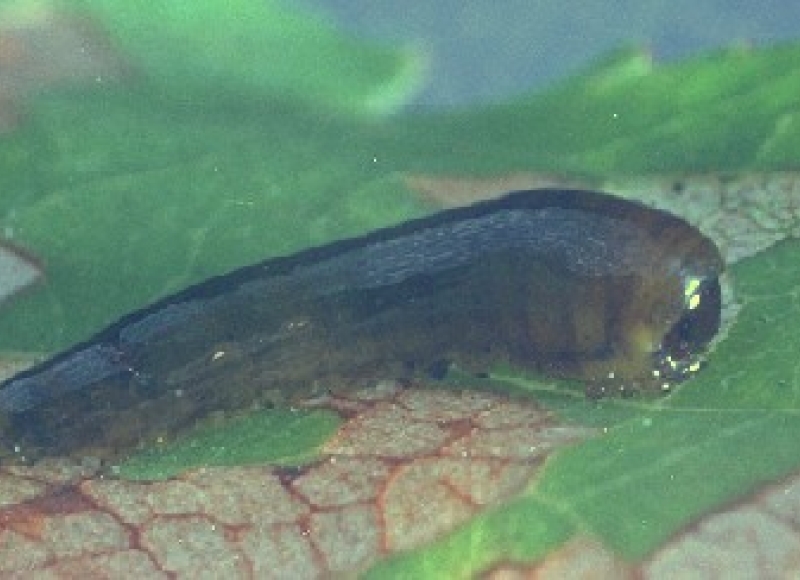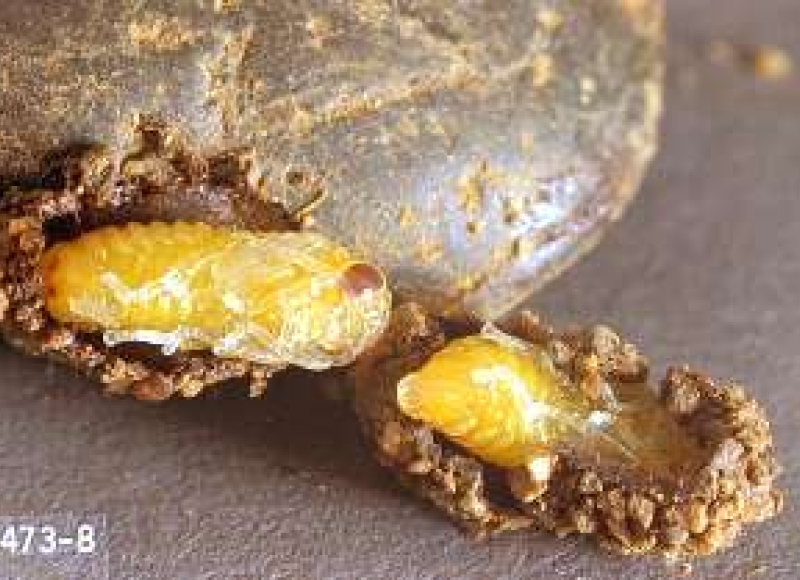Pear sawfly, Caliroa cerasi (L.), is also known as pear slug, cherry slug, and cherry sawfly, and is just one of many sawflies that may feed on ornamental plants.
Description
While pear slugs look similar to small slimey slugs, they are actually larvae of little, dark, thick-waisted wasps which are about 1/5 inch (5 mm) long. The larvae range in size from 0.06 inch to 3/8 inch (1.4-10 mm) long. They are covered in an olive green-to-black layer of slime. They have three pairs of true legs that are barely noticeable under their body.
Life cycle
The overwintering stage is spent as a pupa in a cocoon located about two-to-three inches below the the soil. The adult wasps emerge from the soil in the late spring (April or May) and fly to host plants nearby. Eggs are inserted into leaf tissue. The larvae hatch and go through five stages. They feed for about two-to-three weeks. They then drop to the ground and pupate after the last stage. There are two generations per year. The first brood of larvae is most abundant during June and July. The larvae of the second generation occurs in August and September.
Hosts
Host plants of pear sawfly includes apricot, cherry, cotoneaster, hawthorn, mountain ash, pear, prune, and quince.
Damage
The feeding damage on the leaf first looks like scattered brown spots. As the larvae feed the damage resembles tiny, expanding windowpanes in the leaf. Over the season, the entire leaf may be hollowed out, leaving only the plant veins. Heavily damaged leaves may drop from the plant. The lower leaves are commonly affected first and gradually leaves farther up the trunk are infested. Athough there is some tolerance for damage on the lower leaves, shade tree terminals can be damaged by high populations and continuous feeding by pear sawfly can weaken or stunt nursery stock.
Management
Cultural
Strong jets of water can be used to dislodge limited numbers of pear slugs. Similarly, hand picking of sawflies or infested leaf removal may be useful with small, isolated populations or small plants.
Chemical
Sawflies are susceptible to a range of pesticides. Research from Colorado State evaluated abamectin (Avid 0.15 EC) + superior oil (Sunspray UltraFine Oil), spinosad (Conserve SC), permethrin (Astro), and thiomethoxam (293,343 25 G) for management of pear sawfly on cotoneaster. All treatments provided effective control. See the Guidelines from the PNW Insect Management Handbook for Nurseries or Landscapes under sawflies.
Web Resources
Antonelli, Art. Insect Answers: Pear Slug. Washington State University Extension Fact Sheet. 3 June 2104.
Berry, R. Pear sawfly.Insects and Mites of Economic Importance in the Pacific Northwest. Oregon State University Fact sheet on pearslug. 3 June 2104.
Cranshaw, W.S. and D.A. Leatherman. 2004. Pear slugs. Colorado State University Extension. Updated January 08, 2014. 2 June 2014.
Long, Lynn. 1993. Pear sawfly (pear slug). Orchard Pest Management Online. Tree Fruit Research and Extension Center. Washington State University. 2 June 2014.
Sharon J. Collman and Michael R. Bush. 2013. Pear, flowering (Pyrus)-Pear sawfly (pear slug). PNW Insect Management Handbook. 2 June 2014.
Varela, et al. UC Pest Management Guidelines: Pearslug. 3 June 2014. Note: recommendations are for commercial fruiting pear production.
Additional References:
Berry, Ralph. 1998. Insects and Mites of Economic Importance in the Pacific Northwest, 2nd Ed. OSU Bookstore, Inc. Corvallis, OR, USA. 221 pp.
Schuh, J. and D.C. Mote. 1948. Insect Pests of Nursery and Ornamental Trees and Shrubs in Oregon. Station Bulletin 449. Agricultural Experiment Station, Oregon State College, Corvallis, OR, USA. 164 pp.
Page last modified 6/3/14










